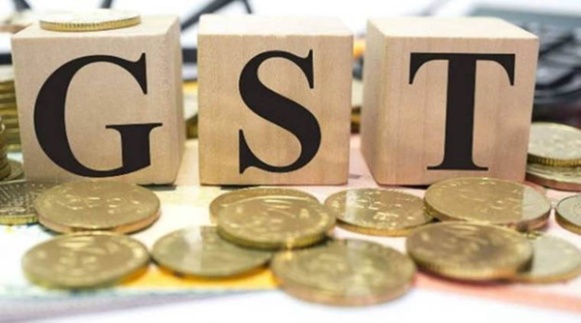ALL TIME HIGH GST COLLECTIONS

Copyright infringement is not intended
Context
- The average monthly gross GST collections for FY22 now stands at Rs 1.23 lakh crore, which is 30.5 per cent higher than the monthly average seen in the previous fiscal. Collections hit all-time high at 1.42 lakh crore.
Factors which have contributed to the surge in collections
- Anti-evasion measures like-detecting the incidence of fake input tax credit and action against fake billers.
- A pick-up in economic activity.
- Rate rationalization measures undertaken by the (GST) Council to correct inverted duty structure.
- Recovery of business activity at faster pace.
- Rebound in gold imports in Feb 2022 post third wave.
- Direct taxes.
- “Base effect” and higher economic growth.
- Nudging non-filers after last date of filing of returns.
- Passing of input tax credit for non-filers.
- Increased formalization: State Bank of India said that the size of the informal economy have shrunk to no more than 20 percent from 52 percent in 2017-18. Formalization is the reason GST collections did not collapse during the pandemic
- Broad based Economic Recovery
- India’s manufacturing activity continued to improve strengthening demand conditions.
- The cumulative output of the core sector industries in the first half of FY22 has risen by 16.6 percent, as compared to a 14.5 percent fall in the same period of the previous financial year.
- Merchandise Exports rose
Divergence among states
- GST collections grew more than 15 per cent for Punjab, Haryana, Odisha, Maharashtra and Andhra Pradesh in March 2022.
- For states such as West Bengal, Jharkhand, Chhattisgarh, Madhya Pradesh, Tamil Nadu, Telangana, Rajasthan and Uttar Pradesh, growth was less than 10 per cent.
- This suggests inter-state variation in consumption and investment growth and provides more support to states’ demand for continuation of GST compensation beyond five years.
Implications of high GST Collection
- Tax experts say the uptrend in GST revenues has come in line with economic recovery and a significant increase in surveillance activities by tax authorities.
- The rise in GST revenues is likely to help the government to surpass its Budget targets.
Does high GST collection suggests good taxation and all good economics?
No.
High indirect tax collection is regressive
- Taking all direct and indirect taxes together, the long-term trend (centre and states combined) shows the annual average of direct tax revenue was 6.6% of the GDP during the past decade of FY12-FY21.
- In the same period, the annual average of indirect tax was far higher at 10.6% of the GDP.
- High indirect tax collection is regressive because indirect tax doesn’t distinguish between the rich and poor (capacity to pay) as everyone pays the same tax rates.
- On the contrary, direct tax is on the income levels/profits and is thus based on the ability-to-pay principle of taxation.
- When indirect taxes rise, tax burden shifts to the poor.
Corporate tax falls below income tax
- Budget documents show, in FY21, corporate tax collection fell to Rs 4.5 lakh crore (23.5% of the gross tax revenue), while that of ‘tax on income other than corporate tax’ went up to Rs 4.6 lakh crore (24.2% of the gross tax revenue).
- This has pulled down the total tax revenue the government needs for higher fiscal spending.
- Also, corporate entities are financially bigger entities with more capacity to pay, while tax on income other than corporate tax is paid by relatively lesser mortals, like individuals (salaried or self-employed), partnership firms, trusts etc.
High oil prices
- The poor not only use more petrol and diesel, they are also burdened with inflation that high oil prices bring- 2014 PPAC Study.
- It is a direct burden on the poor, the second (agriculture) and third (transport sector) add to their cost of food and other essential items (transported) and travel (by bus and train).
Conclusion
- Despite extremely challenging initial years and the pandemic, India's net direct tax collections doubled to more than Rs 1.85 lakh crore in 2021.
- Going forward, government's efforts are expected to build a formidable business ecosystem. These include-
- further liberalize GST norms,
- anti-profiteering measures,
- digitalization of tax records and proceedings,
- exchange of data between CBDT and CBIC,
- simplification of procedures, and lower tax slabs
- A number of factors will have a positive impact on the tax collections. These include:
- Ease of doing business,
- growth in manufacturing,
- increased margins,
- Creation of employment opportunities for the country's growing young population.
- However, low corporate tax and low direct tax means the tax burden shifts to the poor as the government needs more resources for its fiscal spending.
- The pandemic has disproportionately hurt the poor by way of higher loss of lives, jobs and businesses and the impact is visible in low consumption demand in the economy.
- Developed nations collect most tax revenues from direct tax. As per the latest data, the OECD average for direct tax collection in 2018 was 67.3% of the total tax collection, while for India, it was 38.3% (for FY19).
- Going forward, a sluggish demand will continue to drag down growth. Therefore, it is important to reverse the taxation regime in which indirect tax, like the GST, plays a dominant role in total tax revenue.
Read about GST in detail here: https://www.iasgyan.in/daily-current-affairs/goods-and-services-tax-gst



1.png)
